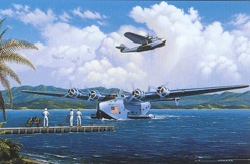|
|
| Tahiti Clippers |
|
 |

|
 |
|
|
| DESCRIPTION |
 |
| 16 x 11.5 Inch Collector Size Unframed Lithograph $40.00
Juan Trippe left Yale University in 1917 to enlist in the U.S. Navy. Trippe became a Naval Aviator on June 17 1918. With the War nearing its end Trippe returned to Yale where he founded the Yale Flying Club. Writing in the May 1919 edition of The Yale Graphic Juan speculated that the new Navy NC flying boats being introduced might be the first to successfully cross the Atlantic and that eventually commercial flights across the Atlantic would be "a perfectly sane commercial proposition." Several years later Trippe was in control of Pan American Airways. Pan Am had a contract to fly mail to Havana utilizing Fokker triplanes. Trippe believed that flying boats possessed advantages in serving South America where rivers harbors or lagoons could make suitable airfields in locations where no adequate facilities existed. In 1927 Pan Am acquired its first flying boat the twin-engine Sikorsky S-36. Five such aircraft were utilized to expand service to additional South American cities. A few years later Pan Am acquired the large four-engine Sikorsky S-40 which was piloted on its maiden flight from Miami to Panama by Charles Lindbergh. The S-40 was not capable of providing transoceanic service but a later variant the S-42 was. An S-42 was utilized to survey the San Francisco to Manila route but the first commercial service was provided utilizing a Martin M-130 a significantly improved aircraft. The biggest and most luxurious of the Pan Am flying boats was the Boeing 314. This huge aircraft was 28 feet high 106 feet long and had a wingspan of 152 feet. Six of these aircraft were delivered to Pan Am in 1939 and they were utilized to provide the first transatlantic commercial service. Two of Pan Am's flying boats or "Clippers" as they were more popularly referred to are depicted in a beautiful south seas setting by aviation artist Stan Stokes. In the foreground taxing to the floating dock is the Dixie Clipper a Boeing 314. The Dixie Clipper inaugurated the first regular transatlantic passenger service in June of 1939 and was utilized by President Roosevelt to attend the Casablanca Conference in 1943. In the background having just lifted off is the China Clipper a Martin M-130. This is the aircraft which departed San Francisco for Manila in 1935 and became the first commercial passenger aircraft to cross the Pacific. In 1968 when Juan Trippe stepped down Pan American Airways had developed an 80000 mile international route structure which served 85 countries. Juan Trippe was a driving force behind the development of international air travel and his marvelous flying boats played a major role in making the man's ambitions a reality. These Clippers were truly some of the classics of America's great aviation heritage. |
|


|